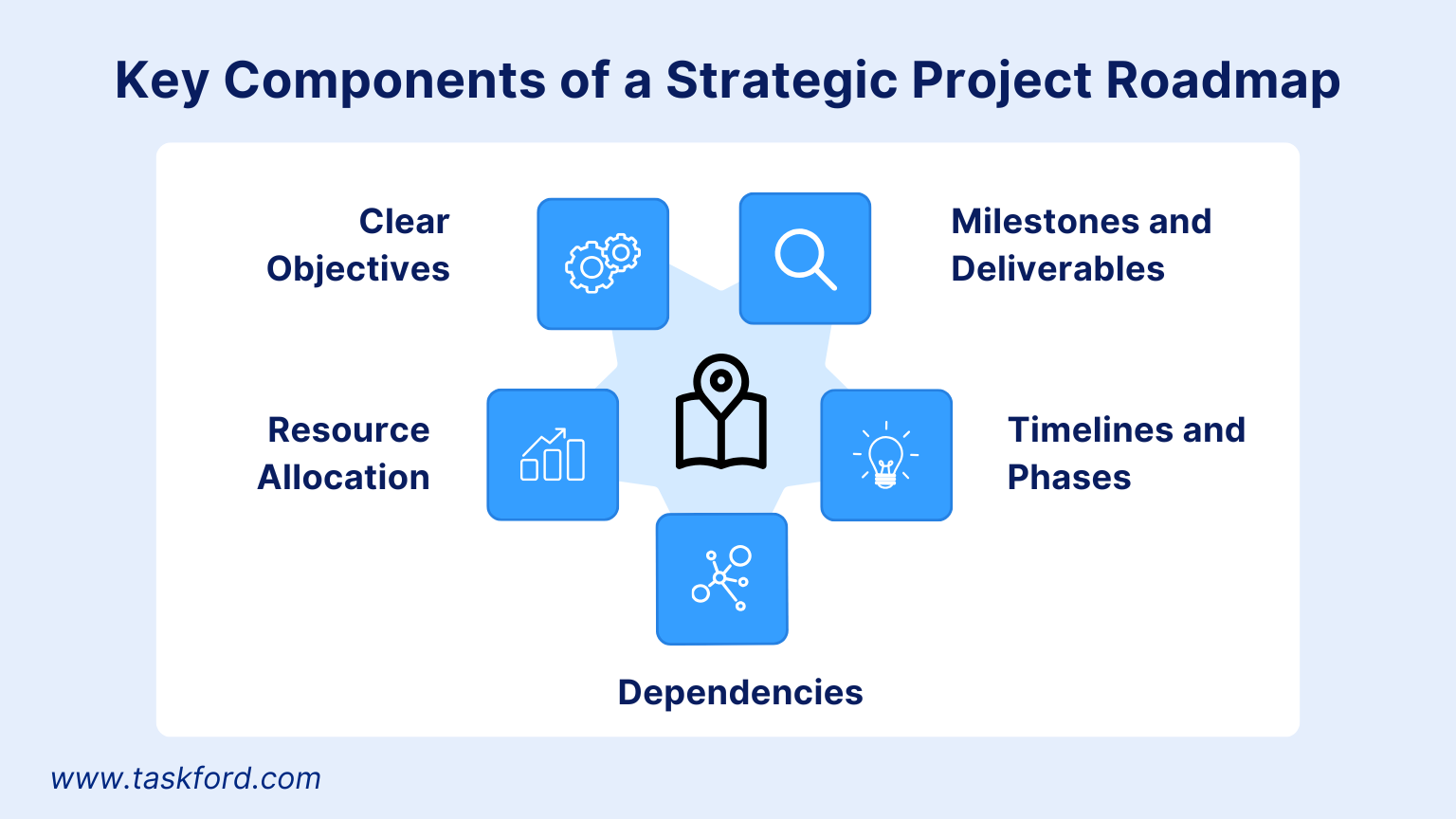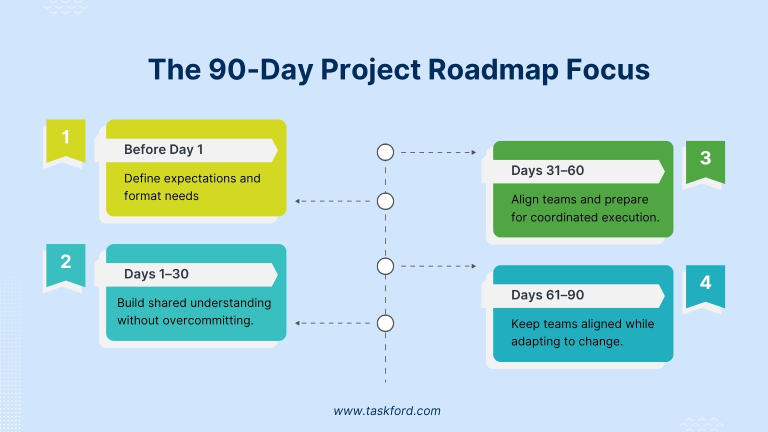The First 90 Days of Any Project: A Roadmap for Project Managers
Learn how to structure your project’s first 90 days using a clear and reusable project roadmap format that drives alignment and results.
The first 90 days of any project can set the tone for everything that follows. It’s the window where clarity, structure, and alignment matter most — and where the right decisions lay the groundwork for successful delivery.
For project managers, this early stage is more than just kickoff meetings and setting deadlines. It’s about crafting a roadmap that guides the team, brings stakeholders together, and helps everyone see what’s coming next. And at the heart of that is choosing a project roadmap format that fits the project’s complexity, pace, and goals.
In this post, we’ll walk through how to approach the first 90 days of a project with purpose. You’ll get a practical, phase-by-phase guide to building a roadmap that’s useful from day one — and adaptable as the work unfolds.
Why Every PM Needs a Tailored Project Roadmap Format
A one-size-fits-all roadmap doesn’t work. Teams move at different speeds, priorities shift, and stakeholders need different levels of detail. A tailored project roadmap format helps you stay aligned, flexible, and focused. Here’s why it matters:
- Teams move differently: Engineering, design, and operations rarely follow the same delivery rhythm. Formats like swimlanes help represent parallel work clearly.
- Dependencies can’t stay hidden: The roadmap should make critical handoffs visible before they become blockers.
- Different views for different people: Leadership wants a strategic view. Delivery teams need details. A good format supports both.
- Plans always change: Early uncertainty is expected. Formats should allow room to shift without losing structure.
- Tools shouldn’t dictate format: Let the project define the format, not the PM tool’s default template.
The format isn’t just a presentation. It’s how you structure decisions, manage change, and keep momentum.
If you’re working on product-focused initiatives, check out our guide on creating a strategic project roadmap to align long-term vision with execution.
Core Elements of a Project Roadmap Format
An effective project roadmap format includes a few key elements that keep plans clear, trackable, and aligned:

- Clear Objectives: Define measurable outcomes—not just activities—so teams understand what they’re working toward.
- Milestone: Highlight critical checkpoints like releases, approvals, or reviews.
- Timelines and Phases: Show when work begins, how it flows, and where transitions occur.
- Dependencies: Make cross-team dependencies obvious. This prevents surprises and delays.
- Resource Allocation: Assign owners to phases and ensure the right people are lined up when needed.
These core elements turn a roadmap from a list of dates into a real planning tool.
The 90-Day Project Roadmap Format: A Practical Framework

Before Day 1: Set Up the Framework
Experienced project managers know that alignment doesn’t begin at kickoff — it starts well before. Before any tasks are assigned or meetings are scheduled, the focus should be on defining how the project will operate and which roadmap format will best support its goals.
This phase is about framing, not filling in details. Rather than rushing to populate a roadmap, use this time to build the foundation that everything else will depend on. That includes:
✅ Setting clear delivery expectations for Days 30, 60, and 90.
✅ Identifying decision-makers who control scope, timing, and approvals.
✅ Listing known constraints like launch deadlines, budget limits, or regulatory requirements.
✅ Choosing the right roadmap format — whether a milestone-led layout, a swimlane for multiple workstreams, or a flexible format to accommodate unknowns.
When done right, this early structure reduces confusion, saves time, and ensures your roadmap format won’t need to be torn apart and rebuilt halfway through the project.
Days 1–30: Discovery, Scoping & Alignment
The first 30 days are about building a shared understanding of what the project needs to achieve and what might get in the way. It’s not about finalizing plans, but about laying down a solid structure the team can align around.
Start by meeting with team leads to clarify priorities, constraints, and cross-functional dependencies. Focus on what’s fixed (like go-live dates or external commitments) and where flexibility is possible.
Use a project roadmap format that supports early-stage planning — ideally, a simple timeline with broad time ranges. Include key milestones, owners, known risks, and open assumptions. Avoid locking in exact dates too early.
The roadmap at this point should focus on sequence and visibility, not task-level detail. Keep the format easy to update and visible to all stakeholders.
By the end of Day 30, aim to have:
✅ A first-pass roadmap that outlines phases and key milestones
✅ A clear list of unknowns or blockers
✅Shared definitions of success and scope
✅ A working roadmap format agreed on across teams
This sets the foundation for delivery planning in the next phase, without overcommitting before you’re ready.
Days 31–60: Planning, Dependencies & Coordination
With discovery complete and direction aligned, this phase shifts from exploration to execution planning. The goal now is to structure work across teams, surface dependencies, and prepare for delivery — using a project roadmap format that supports coordination, not just visibility.
Start by refining the initial roadmap into a more structured format. A swimlane-style roadmap works well here, where each team or workstream is represented in its own horizontal track. This helps visualize who’s doing what, when, and where the work intersects.
Begin mapping key delivery phases and milestones with real owners attached. Focus on:
- Start and end points for major workstreams
- Handoffs between teams
- Dependencies that could block progress
Rather than setting fixed deadlines for everything, anchor work to conditions:
For example, "QA starts after backend API is stable," or "marketing materials depend on final product naming." This keeps the roadmap flexible while staying realistic.
Use the roadmap format to run working sessions with each team. Ask them to review their lane, challenge the sequencing, and flag any blockers or capacity risk. This keeps the format grounded in actual delivery, not assumptions.
By Day 60, your roadmap should be execution-ready. That means:
✅ Milestones are clearly defined and owned
✅ Dependencies are visible and called out
✅ The roadmap reflects actual delivery logic
✅ Teams are aligned on sequencing and confident in what’s coming next
This is the stage where clarity replaces estimation, not through rigid timelines, but through a structure everyone agrees on.
Days 61–90: Start Executing and Keep the Roadmap Alive
Once execution begins, the roadmap needs to evolve from a plan to a live control system.
By now, your project roadmap format should be linked to delivery tools — whether that’s sprint boards, task systems, or something integrated. The format should allow you to track real-time progress, update status, and communicate shifts without rewriting the whole plan.
Useful techniques at this stage:
- Add simple status indicators (e.g., Not Started / In Progress / At Risk).
- Version the roadmap weekly or biweekly, showing what changed and why.
- Keep the format centralized — avoid separate “presentation” roadmaps that fall out of sync with actual work.
By Day 90, you should be able to look back and assess how accurate your roadmap was, what changed, and what needs to shift in the next 90 days. The format should support this reflection, not make it harder.
How Format Should Evolve Across the 90 Days
| Phase | Recommended Format | Focus |
|---|---|---|
| Before Day 1 | Milestone Skeleton + Constraints | Define expectations and format needs |
| Days 1–30 | Timeline with Assumptions | Align on scope, surface unknowns |
| Days 31–60 | Swimlane with Dependencies | Coordinate teams and plan execution |
| Days 61–90 | Live, Trackable Roadmap | Monitor progress and guide decisions |
No single format works for the entire project. The most effective PMs adapt their project roadmap format as needs shift, and make sure it stays usable across teams, not just for presentations.
Final Thought
The first 90 days aren’t just about getting started — they’re about setting the tone for everything that follows. A well-chosen, phase-appropriate project roadmap format gives you more than a plan. It gives you control, clarity, and alignment — all while reducing the noise that slows teams down.
Instead of asking, “Is the roadmap done?”, the better question is: “Does this format help us make better decisions today?”
If the answer is yes, you’re on the right track.
Related Resources
- What Does A Project Manager Do? - A Guide to Advancing Your Career
- Contingency Planning in Project Management
- What is Program Management
- Project Management Terms 80 Key Terms from A to Z in Project Management
Making work simpler,
smarter, and more connected
Join our waitlist and be notified first.

Related Blog
Subscribe for Expert Tips
Unlock expert insights and stay ahead with TaskFord. Sign up now to receive valuable tips, strategies, and updates directly in your inbox.

![7 Must-Have Project Management Documents Every PO Should Know [Free Templates]](https://taskford.com/marketing/blog/project-management-documents.webp)




